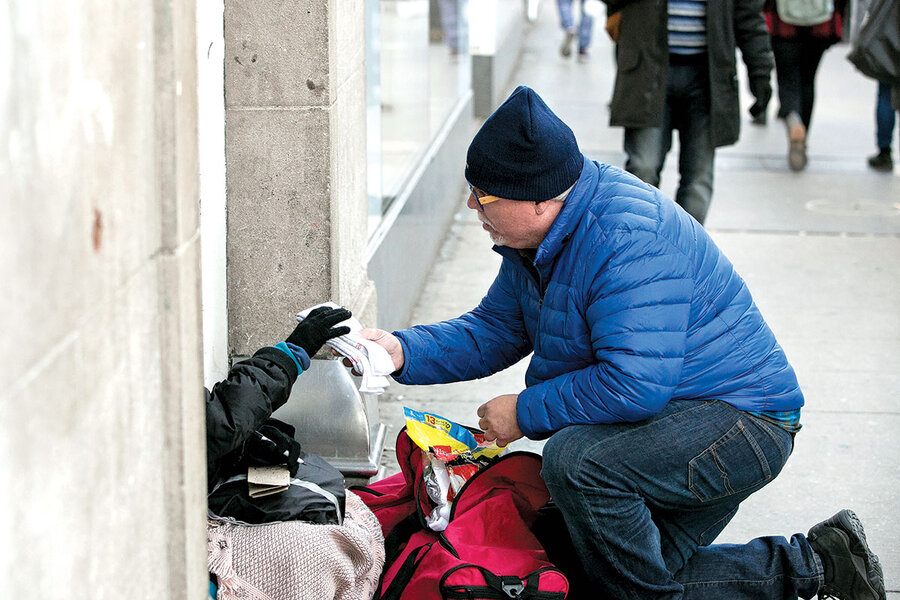A different lens on people facing homelessness
Loading...
| Ithaca, N.Y.
It’s a sprightly 41-degree morning in Ithaca, and Mark Horvath gets his camera rolling. Carmen Guidi, a local advocate for people facing homelessness in this picturesque corner of upstate New York, is upset about a coming reality for residents of the encampment that he and Mr. Horvath are about to enter. Construction plans, Mr. Guidi says, mean that a 15-acre chunk of the site, dubbed The Jungle, is about to become off-limits, and as many as 10 encampments will have to be moved.
“The mayor has asked me to be on a task force to figure out what we can do to help the people,” Mr. Guidi says.
“Housing!” Mr. Horvath interjects.
Why We Wrote This
One former TV executive found a way to make people see what they usually don’t: the ‘invisible’ people on the streets. Mark Horvath's videos have reached hundreds of thousands of viewers and sparked local volunteering efforts.
Here begins one of the latest mini-documentaries produced by Mr. Horvath for the social media project he started 11 years ago: Invisible People. It’s a mobile nonprofit driven by one man, his backpack, and a small, hand-held video camera, and its mission is captured in the terse line greeting visitors to the website invisiblepeople.tv: “Changing the story of homelessness.”
Indeed, these documentaries aim to give a close-up, unfiltered view of homelessness to help people better understand the challenge. The stories told by real people living on the streets, recorded by Mr. Horvath and others, can be raw and harrowing.
“Our inability to relate to homelessness is our biggest obstacle to ending it,” he notes.
On the streets himself
Mr. Horvath knows intimately the perilous predicament of homelessness. Once a high-flying Los Angeles TV executive, he ended up on Hollywood Boulevard amid spiraling drug addiction. Over time, he was able to rebuild his life, eventually landing a marketing job and buying a house. But after the economic collapse in 2008, he again lost everything, almost landing back on the streets. Instead, however, he started making videos of homelessness as he understood it.
Mr. Horvath has filmed in cities across the United States and Canada, and he’s traveled to nine countries for speaking engagements. While on the road, he often attempts to capture a vignette of local homelessness. To increase the number of stories on the Invisible People website, he is also working with a string of journalists around the world.
As Mr. Horvath sees it, “There was no place for kids to go online to learn about homelessness except some academic website where they have to download a 46-page PDF or fundraising materials. So I created one.”
For years, he says, Invisible People had about 20,000 YouTube subscribers, and it struggled to attract donors and philanthropists. But following a few tweaks to the project’s online presentation, the funding started coming, and the number of subscribers now stands at more than 250,000.
But statistics are one thing. Mr. Horvath wants his videos to spark action.
Just two days before Mr. Horvath and Mr. Guidi’s visit to The Jungle, Julia Schellenberg and Ryan Cleare were watching videos on YouTube and stumbled upon an Invisible People film. “It was [a video] in another city,” Ms. Schellenberg says. “Then ... I saw there was one in Ithaca, so I watched it.” That led the young couple to Mr. Guidi, who informed them about a group of volunteers who would be distributing supplies – primarily heaters and propane tanks – to the hardy band of Jungle residents braving the cold temperatures. That’s when Mr. Horvath and his camera showed up, bringing the Invisible People message full circle.
“Work like this – it’s so important, telling people’s stories,” Ms. Schellenberg says. “That’s why we’re here.”
Putting ‘a human face on it’
They’re not the only tangible evidence of the impact of Mr. Horvath’s films. Mr. Guidi points to a spot in the woods where a couple called T.J. and Ally stayed a year ago after losing their jobs. Mr. Horvath did a story on them, which prompted others to come forward with help.
“Two months later, they were housed because of the work he did,” Mr. Guidi says. “It works, brings awareness to the problem, puts a human face on it.”
Mr. Horvath, in turn, points to Mr. Guidi’s work as the kind of grassroots action he wants to inspire. Mr. Guidi, a body shop owner, established a small community of tiny homes called Second Wind Cottages behind his business to house people from places like The Jungle.
Ithaca might not be the first kind of place people think of when it comes to homelessness, but the issue can be acute. “Rural homelessness can often be more challenging because there is not the social services support urban areas have,” Mr. Horvath says. Home to Ithaca College and the prestigious Cornell University, the city is experiencing economic growth. But affordable housing is increasingly scarce.
Deb Wilke, another local volunteer in Mr. Horvath’s orbit, explains how a sum of about $3,500 was generated mostly from college students in town. “It was super cold,” Ms. Wilke says, and she describes the students as saying among themselves, “Can you imagine living outside? We are complaining about walking to class.”







